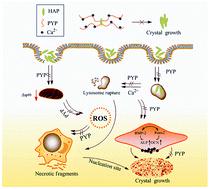当前位置:
X-MOL 学术
›
Food Funct.
›
论文详情
Our official English website, www.x-mol.net, welcomes your
feedback! (Note: you will need to create a separate account there.)
Seaweed Porphyra yezoensis polysaccharides with different molecular weights inhibit hydroxyapatite damage and osteoblast differentiation of A7R5 cells.
Food & Function ( IF 5.1 ) Pub Date : 2020-03-12 , DOI: 10.1039/c9fo01732a Ling-Hong Huang 1 , Hong Liu , Jia-Yun Chen , Xin-Yuan Sun , Zhi-Hui Yao , Jin Han , Jian-Ming Ouyang
Food & Function ( IF 5.1 ) Pub Date : 2020-03-12 , DOI: 10.1039/c9fo01732a Ling-Hong Huang 1 , Hong Liu , Jia-Yun Chen , Xin-Yuan Sun , Zhi-Hui Yao , Jin Han , Jian-Ming Ouyang
Affiliation

|
Vascular calcification (VC) is a common pathological manifestation in patients with cardiovascular diseases, leading to high mortality in patients with chronic kidney diseases. The deposition of hydroxyapatite (HAP) crystals on vascular smooth muscle cells leads to cell damage, which promotes osteogenic transformation. In this study, four different molecular weights (MWs ) of Porphyra yezoensis polysaccharides (PYP1, PYP2, PYP3, and PYP4 with MWs of 576, 49.5, 12.6, and 4.02 kDa, respectively) were used to coat HAP, and the differences in toxicity and calcification of HAP on A7R5 cells before and after coating were studied. The results showed that PYPs could effectively reduce HAP damage to the A7R5 cells. Under the protection of PYPs, cell viability increased and lactate dehydrogenase release, active oxygen level, and cell necrosis rate decreased; also, the amount of the HAP crystals adhering to cell surfaces and entering cells decreased. PYPs with low molecular weights presented better protective effects than high-molecular-weight PYPs. PYPs also inhibited the osteogenic transformation of the A7R5 cells induced by HAP and decreased alkaline phosphatase (ALP) activity and expressions of bone/chondrocyte phenotype genes (runt-related factor 2, ALP, osteopontin, and osteocalcin). In the adenine-induced chronic renal failure (CRF) mouse VC model, PYP4 was found to obviously inhibit the aortic calcium level, and it also inhibited the serum creatinine, serum phosphorus and serum BUN levels. PYP4 (least molecular weight) showed the best inhibitory effect on calcification and may be considered as a candidate drug with therapeutic potential for inhibiting cellular damage and osteoblast differentiation induced by the HAP crystals.
中文翻译:

不同分子量的紫菜紫菜多糖可抑制羟磷灰石损伤和A7R5细胞的成骨细胞分化。
血管钙化(VC)是心血管疾病患者的常见病理表现,导致慢性肾脏疾病患者的高死亡率。羟基磷灰石(HAP)晶体在血管平滑肌细胞上的沉积会导致细胞损伤,从而促进成骨转化。在这项研究中,使用四种不同分子量的紫菜卟啉多糖(MW分别为576、49.5、12.6和4.02 kDa的PYP1,PYP2,PYP3和PYP4)包被HAP,并且毒性差异研究了包被前后A7R5细胞上HAP的表达和钙化。结果表明,PYPs可以有效减少HAP对A7R5细胞的损害。在PYPs的保护下,细胞活力增加,乳酸脱氢酶释放,活性氧水平和细胞坏死率降低。同样,粘附到细胞表面并进入细胞的HAP晶体的数量也减少了。低分子量的PYP表现出比高分子量的PYP更好的保护作用。PYPs还抑制了HAP诱导的A7R5细胞的成骨转化,并降低了碱性磷酸酶(ALP)活性和骨/软骨细胞表型基因(矮子相关因子2,ALP,骨桥蛋白和骨钙蛋白)的表达。在腺嘌呤诱发的慢性肾功能衰竭(CRF)小鼠VC模型中,发现PYP4明显抑制主动脉钙水平,并且还抑制血清肌酐,血清磷和血清BUN水平。
更新日期:2020-03-12
中文翻译:

不同分子量的紫菜紫菜多糖可抑制羟磷灰石损伤和A7R5细胞的成骨细胞分化。
血管钙化(VC)是心血管疾病患者的常见病理表现,导致慢性肾脏疾病患者的高死亡率。羟基磷灰石(HAP)晶体在血管平滑肌细胞上的沉积会导致细胞损伤,从而促进成骨转化。在这项研究中,使用四种不同分子量的紫菜卟啉多糖(MW分别为576、49.5、12.6和4.02 kDa的PYP1,PYP2,PYP3和PYP4)包被HAP,并且毒性差异研究了包被前后A7R5细胞上HAP的表达和钙化。结果表明,PYPs可以有效减少HAP对A7R5细胞的损害。在PYPs的保护下,细胞活力增加,乳酸脱氢酶释放,活性氧水平和细胞坏死率降低。同样,粘附到细胞表面并进入细胞的HAP晶体的数量也减少了。低分子量的PYP表现出比高分子量的PYP更好的保护作用。PYPs还抑制了HAP诱导的A7R5细胞的成骨转化,并降低了碱性磷酸酶(ALP)活性和骨/软骨细胞表型基因(矮子相关因子2,ALP,骨桥蛋白和骨钙蛋白)的表达。在腺嘌呤诱发的慢性肾功能衰竭(CRF)小鼠VC模型中,发现PYP4明显抑制主动脉钙水平,并且还抑制血清肌酐,血清磷和血清BUN水平。











































 京公网安备 11010802027423号
京公网安备 11010802027423号